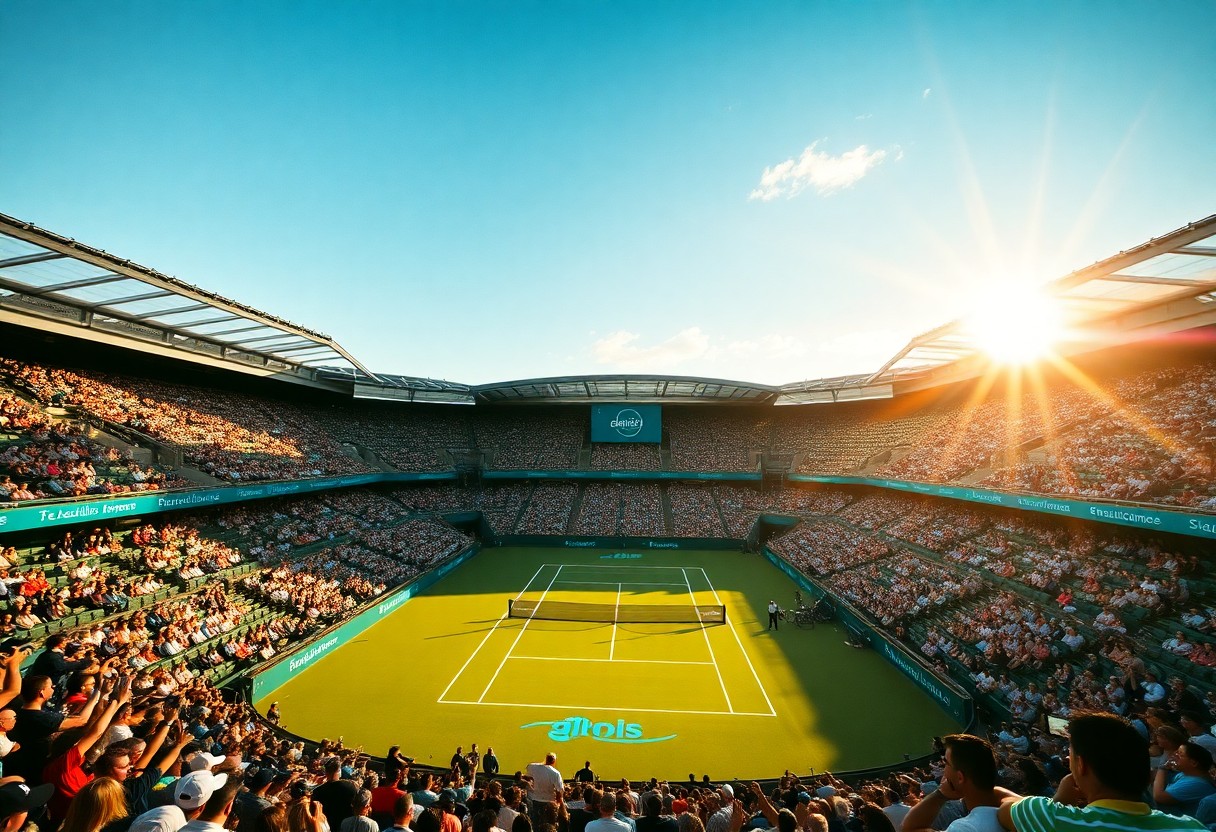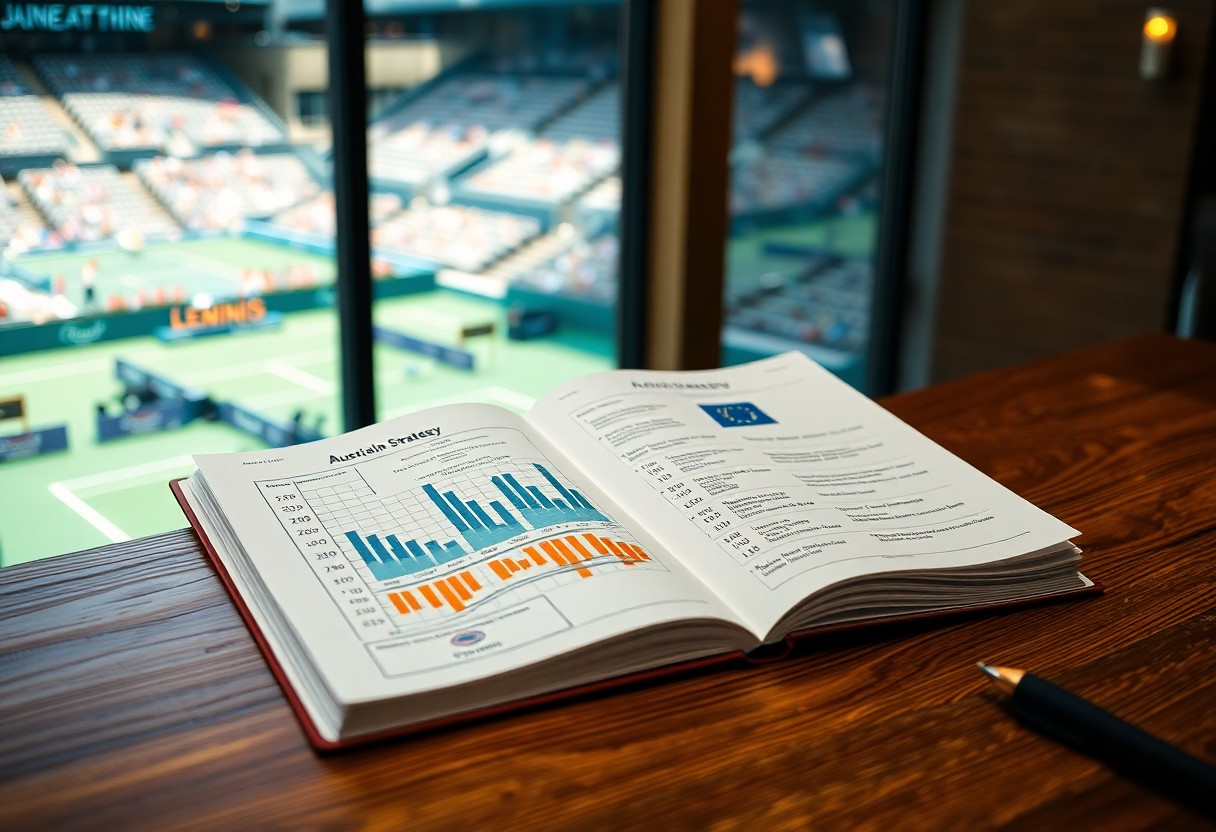With tennis’s four Grand Slam tournaments each offering unique challenges, you’ll find the Australian Open stands apart through its extreme heat conditions and distinctive hard court surface. Your understanding of this tournament’s character begins with recognizing how Melbourne’s scorching summer temperatures can exceed 40°C (104°F), creating brutal playing conditions that test players’ endurance like no other major. You’ll discover that the Plexicushion and GreenSet hard courts provide a medium-fast playing surface that favors aggressive baseline play, while the tournament’s vibrant party atmosphere and late-night scheduling make it the most entertaining Grand Slam for spectators seeking an unforgettable tennis experience.
Unique Timing and Conditions Shaping Play
You’ll notice the Australian Open stands apart from its Grand Slam counterparts through its distinctive seasonal positioning and challenging environmental conditions. January’s scorching summer heat creates a completely different playing atmosphere compared to Wimbledon’s temperate grass courts or the US Open’s late summer conditions. The tournament’s placement at the start of the tennis calendar year forces players to adapt their preparation schedules and physical conditioning strategies. Extreme temperatures regularly exceed 35°C (95°F), transforming matches into endurance battles that test mental fortitude as much as technical skill.
The Australian Open’s January Schedule
Your tennis calendar begins with the Australian Open’s mid-January timing, creating unique challenges that don’t exist at other majors. Players arrive in Melbourne after brief off-season breaks, often carrying fitness concerns or incomplete match preparation. The tournament’s early positioning means you’re watching athletes compete before reaching peak form, leading to more unpredictable results and breakthrough performances from lower-ranked players. This scheduling creates opportunities for upsets that rarely occur at year-end tournaments when players have found their rhythm through months of competition.
Weather Variability and Its Impact on Player Performance
Melbourne’s unpredictable weather patterns create dramatic shifts in playing conditions that you won’t experience at other Grand Slams. Temperatures can swing from scorching 40°C heat to sudden cool changes within hours, forcing players to constantly adjust their strategies mid-match. The extreme heat policy implementation becomes a tactical element itself, with 10-minute breaks activated when temperatures exceed specific thresholds, often disrupting momentum and changing match dynamics completely.
Weather-related interruptions have produced some of the tournament’s most memorable moments, with players collapsing from heat exhaustion or struggling through matches that stretch beyond five hours in brutal conditions. Novak Djokovic’s 2012 final victory over Rafael Nadal lasted 5 hours and 53 minutes in sweltering heat, becoming the longest Grand Slam final in history partly due to the physical demands imposed by Melbourne’s climate. You’ll observe how the extreme conditions separate players who’ve specifically prepared for Australian conditions from those who haven’t adapted their training regimens. The tournament’s retractable roofs on major courts can create stark temperature differences, with covered courts remaining 10-15 degrees cooler than outdoor venues, adding another strategic layer to scheduling and player preparation that doesn’t exist at traditional outdoor-only Grand Slams.
Iconic Venue: More Than Just a Stadium
You’ll find yourself stepping into tennis history when you enter Melbourne Park, where the Australian Open’s unique character stems from more than just world-class courts. The venue transforms into a vibrant entertainment precinct during tournament fortnight, offering you experiences that extend far beyond traditional tennis viewing. Melbourne Park hosts over 800,000 visitors annually, making it the most attended Grand Slam, with its distinctive blue courts creating a visual spectacle that sets it apart from Wimbledon’s grass, Roland Garros’ clay, or the US Open’s hard courts. The venue’s integration with Melbourne’s cultural landscape gives you access to the city’s renowned food scene, live music, and late-night entertainment right within the tournament grounds.
The Significance of Melbourne Park
Melbourne Park’s location along the Yarra River positions you at the heart of Australia’s sporting capital, where the venue serves as a year-round entertainment hub rather than a seasonal tennis facility. The precinct covers 40 hectares and houses multiple sports venues, including AAMI Park and Melbourne Rectangular Stadium, creating a sports and entertainment ecosystem unique among Grand Slam venues. You’re experiencing tennis in a setting that reflects Australia’s outdoor lifestyle and multicultural identity, with the venue’s design incorporating native Australian flora and architectural elements that celebrate the country’s heritage while maintaining world-class functionality.
Infrastructure and Innovation at the Tournament
You’ll witness cutting-edge technology integration that positions the Australian Open as the most technologically advanced Grand Slam tournament. Rod Laver Arena’s retractable roof can close in just 5 minutes, while the venue’s comprehensive WiFi network handles over 15 terabytes of data during the tournament fortnight. The Australian Open pioneered the use of Hawk-Eye technology across all courts and introduced real-time player tracking systems that provide you with unprecedented insights into match statistics and player performance metrics.
Your tournament experience benefits from innovations like the AO app, which uses augmented reality to help you navigate the grounds and provides personalized scheduling based on your preferences. The venue’s cooling systems pump chilled air through underground networks to combat Melbourne’s extreme heat, while the tournament’s sustainability initiatives include solar panels that generate 1.2 megawatts of renewable energy. You’re also experiencing the benefits of the venue’s advanced court surface technology, where the Plexicushion surface is specifically designed to reduce player fatigue while maintaining consistent ball bounce across all courts. The tournament’s commitment to accessibility includes audio-described commentary in multiple languages and specialized viewing areas that accommodate over 1,000 wheelchair users simultaneously.
Player Experience: What Sets It Apart
You’ll notice players consistently rank the Australian Open among their favorite tournaments, and it’s not just about the prize money or prestige. The tournament’s commitment to creating an optimal playing environment extends far beyond the courts themselves, with dedicated player lounges, state-of-the-art recovery facilities, and personalized support services that many competitors describe as unmatched. The relaxed Australian atmosphere combines with professional excellence, creating an environment where you can witness players genuinely enjoying their time both on and off court during the competition.
Fan Engagement and Accessibility
You can get closer to tennis superstars at the Australian Open than virtually any other Grand Slam, thanks to innovative fan zones and practice court access that puts you within meters of your favorite players. The tournament pioneered the “AO Live” concept, where you’ll find interactive experiences, player meet-and-greets, and behind-the-scenes access that transforms spectating into participation. Ground pass tickets remain remarkably affordable compared to other majors, allowing you to explore multiple courts and soak up the festival atmosphere without breaking the bank.
The Emphasis on Player Well-Being and Amenities
Melbourne Park houses the most comprehensive player facilities of any Grand Slam venue, featuring dedicated recovery pools, massage therapy rooms, and nutrition centers that operate around the clock during the tournament. You’ll find players praising the spacious locker rooms, private dining areas, and family-friendly spaces that allow them to maintain normal routines despite the intense competition schedule. The tournament’s investment in player comfort shows in retention rates, with participation levels consistently higher than other majors.
The player amenities extend into areas you might not expect, with dedicated childcare facilities allowing touring parents to bring their families without disruption to their preparation routines. The tournament provides complimentary transportation, personalized meal planning, and even cultural experiences that help international players adjust to the Australian summer and time zone changes. Medical facilities rival those of professional sports franchises, staffed by specialists in tennis-specific injuries and recovery protocols. Players frequently mention the seamless coordination between practice scheduling, media obligations, and personal time, with tournament organizers employing sophisticated logistics software to minimize conflicts and maximize preparation opportunities. The “Player’s Lounge” concept has been copied by other tournaments but never quite replicated, featuring everything from gaming areas and quiet zones to business centers where players can handle sponsorship obligations between matches.
Distinctive Playing Surface: Hard Courts with a Twist
You’ll discover that the Australian Open’s courts aren’t just any ordinary hard courts – they feature a unique composition that sets them apart from standard tennis surfaces. The tournament uses Plexicushion, a specialized acrylic surface that provides medium-fast playing conditions with enhanced shock absorption. This surface creates a distinctive bounce pattern that favors aggressive baseline play while still rewarding net rushers who time their approaches correctly. Players often describe the courts as having a slightly slower pace than the US Open but faster than many indoor hard courts, creating a perfect balance for entertaining tennis.
The Composition and Characteristics of the Australian Open’s Courts
Plexicushion consists of multiple layers including a cushioned acrylic base topped with a textured playing surface that provides consistent ball bounce and player comfort. The surface incorporates recycled rubber particles that reduce joint stress by up to 20% compared to traditional hard courts. You’ll notice the distinctive blue and green color scheme, which was specifically chosen to enhance television viewing and reduce glare under Melbourne’s intense summer sun. The courts maintain their playing characteristics even in temperatures exceeding 40°C (104°F), though the surface can become noticeably faster as heat increases throughout the day.
Comparison with Other Grand Slam Surfaces
Each Grand Slam tournament offers dramatically different playing conditions that test various aspects of your tennis skills. The surface variations create unique tactical challenges that separate the versatile champions from specialists.
| Tournament | Surface Characteristics |
| Australian Open (Plexicushion) | Medium-fast pace, consistent bounce, heat-resistant, cushioned for joint protection |
| French Open (Clay) | Slow pace, high bounce, favors defensive play, requires sliding technique |
| Wimbledon (Grass) | Fast pace, low bounce, unpredictable surface, rewards serve-and-volley |
| US Open (DecoTurf) | Fast hard court, lower bounce than Australian Open, abrasive surface |
The transition between these surfaces presents one of tennis’s greatest challenges – players who dominate on clay may struggle on grass within weeks. Only 8 players in tennis history have achieved the Career Grand Slam, partly due to these surface differences. Australian Open champions typically possess strong baseline games with the ability to construct points patiently, yet finish aggressively when opportunities arise. The Plexicushion surface rewards players who can adapt their timing throughout matches, as the court’s speed can vary significantly between the cooler morning sessions and the scorching afternoon heat that Melbourne delivers.
Cultural Influences: A Celebration of Diversity
Melbourne’s multicultural fabric weaves directly into the Australian Open experience, creating an atmosphere you won’t find at Wimbledon’s traditional tea culture or Roland Garros’ Parisian sophistication. Over 40% of Melbourne’s population was born overseas, and this diversity transforms the tournament into a global celebration where you’ll hear dozens of languages courtside and taste authentic cuisines from every continent. The tournament embraces this melting pot identity, featuring cultural performances, diverse food offerings, and celebrations that reflect Australia’s immigrant heritage, making each match feel like an international festival rather than just a tennis competition.
The Australian Open’s Global Appeal
You’ll notice the tournament’s scheduling gives it a unique advantage in attracting global audiences – prime time matches in Melbourne air during morning hours across Asia, capturing massive viewership from China, Japan, and Southeast Asia. This timing, combined with Australia’s reputation as a welcoming destination, draws international visitors who extend their stay into full vacations. The tournament capitalizes on this by offering multi-day packages that include city tours and cultural experiences, positioning itself as both a sporting event and a gateway to Australian culture that other Grand Slams simply cannot match.
Local Traditions and How They Enrich the Tournament Experience
Australian sporting culture brings a refreshingly casual approach that transforms your tournament experience from formal observation to active participation. The “Aussie Aussie Aussie, Oi Oi Oi” chants echo across courts, while the tradition of the “People’s Sunday” offers you ground pass access to practice courts and outer courts for just $25. You’ll find yourself part of the famous Hill crowd atmosphere, where spectators create their own entertainment between points, and the relaxed dress code means you can enjoy world-class tennis in shorts and flip-flops.
The tournament’s integration with local summer traditions creates experiences you won’t encounter elsewhere in the tennis calendar. Australia Day celebrations coincide with the tournament’s second week, bringing citizenship ceremonies, cultural displays, and patriotic festivities directly onto the grounds. You can participate in traditional Aboriginal welcome ceremonies, watch didgeridoo performances on the main plaza, and experience the unique Australian concept of “mateship” – where strangers share sunscreen, offer spare seats, and collectively groan at missed opportunities regardless of which player they’re supporting. The tournament’s famous “Fanatics” sections encourage you to dress in bright colors, wave flags, and create the kind of boisterous atmosphere that would raise eyebrows at other Grand Slams but perfectly captures the Australian spirit of making sport accessible and enjoyable for everyone.
Final Words
Now you understand what sets the Australian Open apart from its Grand Slam counterparts. From its unique summer scheduling and extreme heat challenges to the innovative retractable roofs and vibrant Melbourne atmosphere, you’ve seen how this tournament carves its own identity. The combination of modern facilities, passionate local crowds, and distinctive playing conditions creates an experience unlike Wimbledon’s tradition, Roland Garros’ clay courts, or the US Open’s hard-court intensity. When you watch future Australian Opens, you’ll appreciate how these elements blend to make it tennis’s most distinctive major championship.




